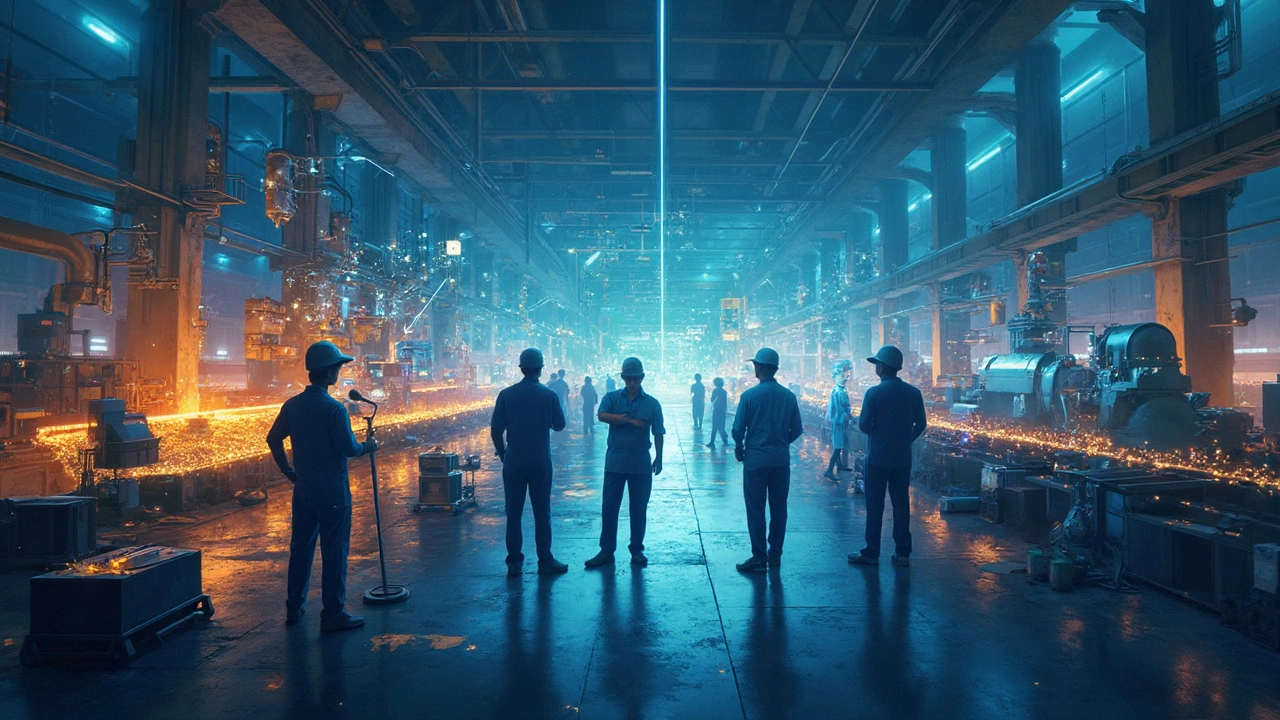
It's fascinating how manufacturing has shaped our lives, transforming raw materials into the countless products we use every day. Behind this magic are different manufacturing systems, each with its strengths and quirks. You’d think manufacturing is just about churning out products, but there's a lot more to it. Know what's wild? The type of manufacturing system you pick can actually make or break your production efficiency. Let's dive into what these systems are all about.
Picture this: you've got job production, which is all about crafting unique, specialized items one at a time. Think of custom-made bicycles or bespoke furniture. Then there's batch production, where a set number of similar items are produced in a series, like your favorite cookies from the local bakery. It's perfect for small to mid-sized runs with a focus on quality and flexibility.
- Introduction to Manufacturing Systems
- Job Production
- Batch Production
- Mass Production
- Continuous Production
- Choosing the Right System for Your Needs
Introduction to Manufacturing Systems
Manufacturing might seem like a straightforward concept, but there's a whole bunch of science and strategy behind it. At its core, manufacturing is all about turning raw ingredients into something useful, like making smartphones from metals and plastics. The way this happens varies greatly, thanks to different manufacturing systems.
Now, why should you care about the type of system used? Well, the effectiveness and efficiency of transforming raw materials into finished goods can impact everything from cost to quality. This is super important in industries like automotive or electronics, where precision is key. Plus, with various government schemes supporting industry innovation, choosing the right system plays a critical role in boosting production and staying competitive.
Here's where it gets interesting: Different systems cater to different needs. Back in the day, Henry Ford revolutionized the world with the introduction of the assembly line, bringing mass production into the spotlight. But it's not all about making things in large numbers. Today, we have job production for unique, tailor-made goods, batch production for limited runs with consistent quality, and continuous production for high-volume, nonstop output.
Take a look at the key distinctions:
- Job Production: Perfect for custom or specialty items, focusing on high quality one-off products.
- Batch Production: Ideal for manufacturing a specific quantity of items, allowing for adjustments and quality checks between batches.
- Mass Production: Efficient for producing large volumes of identical items quickly and cheaply.
- Continuous Production: Used for high-demand products that require uninterrupted production to meet market needs.
Each of these systems has its own sweet spot and challenges, shaping everything from pricing to workforce requirements. By understanding them, companies can better align their production methods with their business goals and market demands.
Job Production
Job production is like the artisanal way of getting things done in the manufacturing systems world. It's all about crafting unique items, which means every product that rolls out is special and tailored to exact specifications. Imagine custom wedding dresses or handcrafted guitars—these are classic examples of job production. The beauty here is in the detail and the precision, not speed.
This system is ideal for projects that don’t require high volume but demand high quality or specialization. It’s often used in industries where customization is key, like in boutique furniture design or specialized machine components. Your friendly neighborhood carpenter making that perfectly fitted bookshelf? They're using job production.
The process usually involves a skilled workforce who can adapt to different needs and specifications for each project. Flexibility is crucial because no two jobs are exactly the same. What's interesting about job production is its potential to evolve with technology. Even with automation on the rise, having that human touch often remains a unique selling point.
Because job production focuses on single items, costs can sometimes be higher compared to other production methods. But for projects where quality can't be compromised, this method's personalized attention is worth every penny. Entrepreneurs who build their offerings around customization often bank on job production to set themselves apart in the marketplace.
Batch Production
Alright, let's talk about batch production, one of those essential manufacturing systems you might bump into in the industrial world. Imagine you've got a factory keen on producing a specific number of widgets—neither thousands at a time nor just a handful. That's where batch production comes in. It's like cooking a big pot of soup: you make a batch, serve it up, and then start over with the next batch.
In batch production, manufacturers churn out a set quantity of identical products before switching over to a new batch. It’s a middle ground between singular item production and full-blown mass production. This method is super flexible and can accommodate changes in demand or design tweaks.
One of the coolest things about batch production is its versatility. Say some robot parts are the thing of the future, and suddenly everyone wants them. A factory can switch things up relatively quickly to meet that new demand. Plus, with smaller production runs, there's usually less waste compared to those massive assembly line operations.
Here's a fun fact: the food industry often uses batch production for stuff like bread and candy. They make a batch, sell it, and then start another run. Ever wonder why sometimes your favorite snack tastes slightly different? That could be a tweak in the production batch, adjusting flavor or ingredients based on consumer feedback.
Now, working in batches doesn't come without its hurdles. There’s the downtime between different batches when machines need retooling—a bit like changing costumes between acts in a play. But with the ever-evolving government schemes aimed at supporting the manufacturing sector, even this downtime can be minimized thanks to state-of-the-art tech support and subsidies for innovation.
So, if you’re a company juggling a few diverse products that need to adapt to market whims, batch production could be your best buddy. Keep it flexible, stay agile, and watch your business adapt to the ever-changing tides of demand.

Mass Production
Alright, let’s talk about mass production, the real heavyweight in the manufacturing world. This system is all about making a heck of a lot of stuff, real fast. It’s the backbone of industries like automotive and electronics, where the goal is to produce large quantities without losing efficiency or breaking the bank.
Imagine assembly lines buzzing with activity, robots and humans working side by side to deliver a product ready for global markets. Ford revolutionized the game with the assembly line for cars, sparking a mass production revolution. This approach isn’t just about volume; it's about optimizing every step, shaving off time where possible to boost productivity.
The key components are standardization and specialization. Parts are usually uniform, which means they can be pieced together in endless cycles without a hitch. Workers or machines specialize in specific tasks, doing the same thing repeatedly to crank out products like clockwork.
Want to know a cool fact? Almost 80% of the world’s manufacturing output is attributed to mass production methods. It’s like having your cake and eating it too, but on an industrial scale! However, it’s not all rosy. The setup can be costly, and altering any part of this well-oiled machine can be time-consuming and expensive.
But when it’s done right, oh boy! Products like smartphones and cars get churned out faster and more cost-effectively than you can say 'assembly line'. It’s the juggernaut of manufacturing systems because it strikes a balance between speed, cost, and consistency, making it a key player in modern industry.
Continuous Production
So, is continuous production like the ultimate marathon of manufacturing? Pretty much! This system's all about non-stop production flows, ideal for high-demand products. Imagine your local power plant or a massive oil refinery; they can’t afford to stop and start all the time. They need to keep going 24/7.
The magic of continuous production lies in its ability to produce items on a large scale with efficiency and consistency. It’s perfect for industries that require a steady supply of the same product, day in and day out. Think of things like chemicals, paper, or even beverages. By running continuously, manufacturers can minimize downtime and reduce those pesky start-up and shutdown costs.
Here’s a nifty fact: in continuous production, the whole setup is typically automated. Machines and systems are interlinked to keep the flow smooth and uninterrupted. The cool part? Fewer human interventions mean fewer delays and botched products.
Take a look at this straightforward breakdown of what makes continuous production tick:
- Stability: Once you get it rolling, it’s like a well-oiled machine with fewer disruptions.
- Efficiency: With fewer stops, resources and energy are used more efficiently, which translates to cost savings.
- Consistency: Maintains product quality over long runs, vital for meeting standardized specifications.
- Automation: Heavy reliance on automated processes, reducing labor costs and errors.
Just a heads up, though: setting up a continuous production line isn’t cheap, and it won’t work for every product type. Industries involved in this need a hefty initial investment to get started but often find it pays off in the long run with reduced unit costs when they hit high volumes.
Government schemes and incentives often support continuous production initiatives, especially in industries like energy and manufacturing, where innovation can lead to greater energy efficiency and lower emissions.
Choosing the Right System for Your Needs
Deciding on the right manufacturing system isn't as straightforward as picking your favorite ice cream flavor. It requires a clear understanding of your product, market demands, and operational capabilities. But don't sweat it—I've got your back with some handy tips to make this decision a bit easier.
First things first, consider the volume of products you plan to manufacture. If you’re looking at producing something unique or specialized in small quantities, then job production might be your best bet. It's like having your own personal craftsman for every item. On the flip side, if you need to churn out high volumes with little variation, then mass production is the way to go. Fast and efficient, like running an industrial marathon.
Next, think about the flexibility you need. Batch production offers a middle ground—it lets you produce different batches of products without the hefty setup time each time you switch. Perfect for those who want to keep their options open. Meanwhile, continuous production is ideal for industries where stopping the line is simply not an option, like oil refineries or chemical manufacturers.
Don't forget the role of technology. Advanced manufacturing systems, like smart factories using IoT or AI, can drastically affect your choice. These systems can optimize production and inventory management, cutting costs and boosting efficiency. Also, keep an eye on government schemes for manufacturing. They offer incentives or support for adopting sustainable and innovative production methods, which can make switching to a new system more feasible.
- Assess your production volume and variability needs.
- Evaluate the flexibility required in production.
- Consider technological integration and advancements.
- Explore available government schemes supporting innovation.
Remember, the right system should align with both your current needs and future growth plans. It's like putting your manufacturing setup on autopilot—a smooth and efficient ride should be the ultimate goal. Once you nail down the right choice, you'll see how it can positively transform both production efficiency and profitability.




